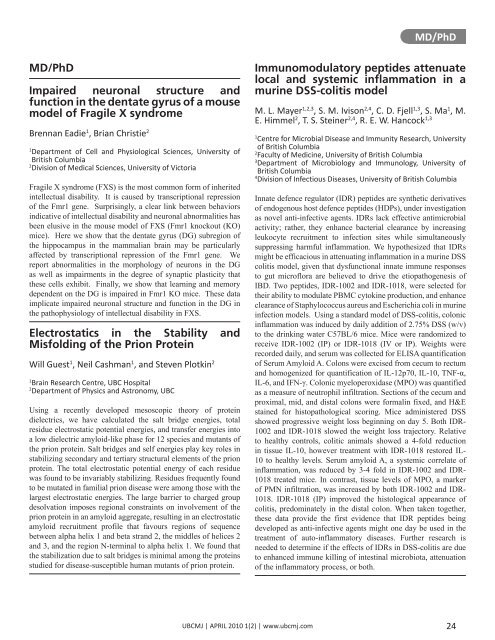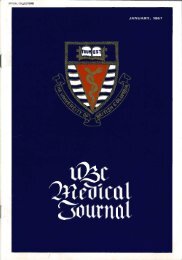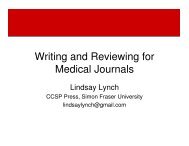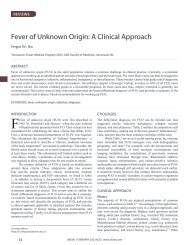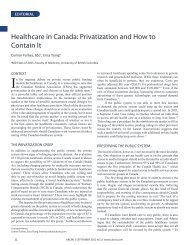Download full PDF - UBC Medical Journal
Download full PDF - UBC Medical Journal
Download full PDF - UBC Medical Journal
You also want an ePaper? Increase the reach of your titles
YUMPU automatically turns print PDFs into web optimized ePapers that Google loves.
MD/PhD<br />
MD/PhD<br />
Impaired neuronal structure and<br />
function in the dentate gyrus of a mouse<br />
model of Fragile X syndrome<br />
Brennan Eadie 1 , Brian Christie 2<br />
1<br />
Department of Cell and Physiological Sciences, University of<br />
British Columbia<br />
2<br />
Division of <strong>Medical</strong> Sciences, University of Victoria<br />
Fragile X syndrome (FXS) is the most common form of inherited<br />
intellectual disability. It is caused by transcriptional repression<br />
of the Fmr1 gene. Surprisingly, a clear link between behaviors<br />
indicative of intellectual disability and neuronal abnormalities has<br />
been elusive in the mouse model of FXS (Fmr1 knockout (KO)<br />
mice). Here we show that the dentate gyrus (DG) subregion of<br />
the hippocampus in the mammalian brain may be particularly<br />
affected by transcriptional repression of the Fmr1 gene. We<br />
report abnormalities in the morphology of neurons in the DG<br />
as well as impairments in the degree of synaptic plasticity that<br />
these cells exhibit. Finally, we show that learning and memory<br />
dependent on the DG is impaired in Fmr1 KO mice. These data<br />
implicate impaired neuronal structure and function in the DG in<br />
the pathophysiology of intellectual disability in FXS.<br />
Electrostatics in the Stability and<br />
Misfolding of the Prion Protein<br />
Will Guest 1 , Neil Cashman 1 , and Steven Plotkin 2<br />
1<br />
Brain Research Centre, <strong>UBC</strong> Hospital<br />
2<br />
Department of Physics and Astronomy, <strong>UBC</strong><br />
Using a recently developed mesoscopic theory of protein<br />
dielectrics, we have calculated the salt bridge energies, total<br />
residue electrostatic potential energies, and transfer energies into<br />
a low dielectric amyloid-like phase for 12 species and mutants of<br />
the prion protein. Salt bridges and self energies play key roles in<br />
stabilizing secondary and tertiary structural elements of the prion<br />
protein. The total electrostatic potential energy of each residue<br />
was found to be invariably stabilizing. Residues frequently found<br />
to be mutated in familial prion disease were among those with the<br />
largest electrostatic energies. The large barrier to charged group<br />
desolvation imposes regional constraints on involvement of the<br />
prion protein in an amyloid aggregate, resulting in an electrostatic<br />
amyloid recruitment profile that favours regions of sequence<br />
between alpha helix 1 and beta strand 2, the middles of helices 2<br />
and 3, and the region N-terminal to alpha helix 1. We found that<br />
the stabilization due to salt bridges is minimal among the proteins<br />
studied for disease-susceptible human mutants of prion protein.<br />
Immunomodulatory peptides attenuate<br />
local and systemic inflammation in a<br />
murine DSS-colitis model<br />
M. L. Mayer 1,2,3 , S. M. Ivison 2,4 , C. D. Fjell 1,3 , S. Ma 1 , M.<br />
E. Himmel 2 , T. S. Steiner 2,4 , R. E. W. Hancock 1,3<br />
1<br />
Centre for Microbial Disease and Immunity Research, University<br />
of British Columbia<br />
2<br />
Faculty of Medicine, University of British Columbia<br />
3<br />
Department of Microbiology and Immunology, University of<br />
British Columbia<br />
4<br />
Division of Infectious Diseases, University of British Columbia<br />
Innate defence regulator (IDR) peptides are synthetic derivatives<br />
of endogenous host defence peptides (HDPs), under investigation<br />
as novel anti-infective agents. IDRs lack effective antimicrobial<br />
activity; rather, they enhance bacterial clearance by increasing<br />
leukocyte recruitment to infection sites while simultaneously<br />
suppressing harmful inflammation. We hypothesized that IDRs<br />
might be efficacious in attenuating inflammation in a murine DSS<br />
colitis model, given that dysfunctional innate immune responses<br />
to gut microflora are believed to drive the etiopathogenesis of<br />
IBD. Two peptides, IDR-1002 and IDR-1018, were selected for<br />
their ability to modulate PBMC cytokine production, and enhance<br />
clearance of Staphylococcus aureus and Escherichia coli in murine<br />
infection models. Using a standard model of DSS-colitis, colonic<br />
inflammation was induced by daily addition of 2.75% DSS (w/v)<br />
to the drinking water C57BL/6 mice. Mice were randomized to<br />
receive IDR-1002 (IP) or IDR-1018 (IV or IP). Weights were<br />
recorded daily, and serum was collected for ELISA quantification<br />
of Serum Amyloid A. Colons were excised from cecum to rectum<br />
and homogenized for quantification of IL-12p70, IL-10, TNF-α,<br />
IL-6, and IFN-γ. Colonic myeloperoxidase (MPO) was quantified<br />
as a measure of neutrophil infiltration. Sections of the cecum and<br />
proximal, mid, and distal colons were formalin fixed, and H&E<br />
stained for histopathological scoring. Mice administered DSS<br />
showed progressive weight loss beginning on day 5. Both IDR-<br />
1002 and IDR-1018 slowed the weight loss trajectory. Relative<br />
to healthy controls, colitic animals showed a 4-fold reduction<br />
in tissue IL-10, however treatment with IDR-1018 restored IL-<br />
10 to healthy levels. Serum amyloid A, a systemic correlate of<br />
inflammation, was reduced by 3-4 fold in IDR-1002 and IDR-<br />
1018 treated mice. In contrast, tissue levels of MPO, a marker<br />
of PMN infiltration, was increased by both IDR-1002 and IDR-<br />
1018. IDR-1018 (IP) improved the histological appearance of<br />
colitis, predominately in the distal colon. When taken together,<br />
these data provide the first evidence that IDR peptides being<br />
developed as anti-infective agents might one day be used in the<br />
treatment of auto-inflammatory diseases. Further research is<br />
needed to determine if the effects of IDRs in DSS-colitis are due<br />
to enhanced immune killing of intestinal microbiota, attenuation<br />
of the inflammatory process, or both.<br />
<strong>UBC</strong>MJ | APRIL 2010 1(2) | www.ubcmj.com 24


